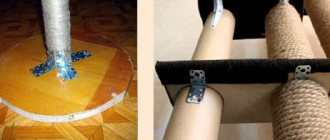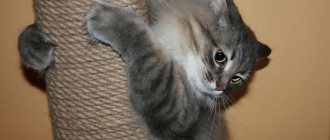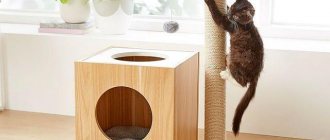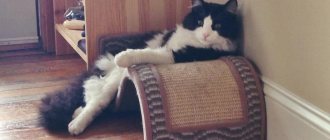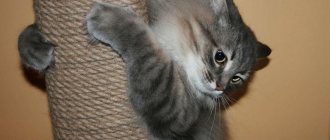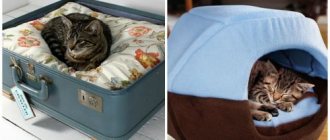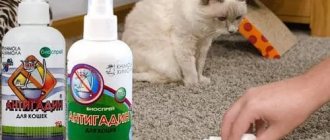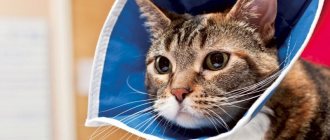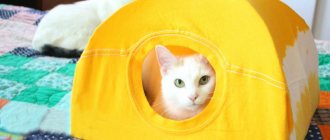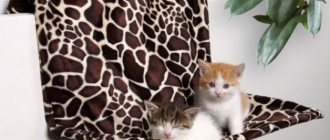A cat collar has different functions.
What does a person think about when he hears the word “collar”? Of course, about the dog. It is unlikely that, for example, the image of a Scottish fold cat, decorously walking around the apartment with a leather accessory around its neck, which also rings, appears in your head.
The article tells you what types of neck straps there are, which ones you can’t make yourself, and which ones you can. You will also learn how to accustom your cat to the accessory.
Why do you need a collar?
The accessory has its own role. At cat shows, the pet’s neck is decorated not just with a strap made of cheap fabric, but with an entire work of art. The owner will most likely make a collar for the cat with his own hands.
For furry pets, there are two types of neck straps that have practical applications:
- A collar with an address tag containing the owner's phone number.
- A special flea and tick collar will keep your pet healthy during the period when bloodsuckers are active.
We sew a textile cat - for cat lovers
After all, it is difficult to find a more elegant and charismatic character than a cat. That is why mustachioed striped animals often inspire their talented owners to perform handicraft feats.
Today we will continue this glorious tradition and make a textile cat with our own hands. And not even just one, but a whole company. It is only in the song that it is sung that the cat walks on its own. Our textile cats will appear before the public in a large and friendly company.
Ladies First!
We present to your attention the charming kitty Kitty, who opens a cat master class. Kind, gentle, with a very soft character, the baby will be made of soft fabric - white fleece. And since she is also cheerful, we will try to make her movable legs with our own hands so that Kitty can play with her friends.
And for this we need:
- paper pattern;
- white fleece or velor for the body;
- a piece of fabric for the dress and, if desired, for the lining;
- pieces of pink and lilac felt for shoes;
- a fragment of a stationery folder for inserts into feet and shoes;
- synthetic fluff as filling;
- black buttons or a piece of black felt (for the eyes);
- yellow felt or self-hardening modeling compound (to make the nose);
- wooden spool of thread;
- threads, needle;
- Moment-Crystal glue, colorless varnish;
- decorative elements: bows, flowers, ribbons or pendants;
- sewing machine.
Welcome to the master class!
To begin, we lay out the pattern pieces on white fabric and cut out the details of Kitty’s body, after which we cut out all the elements for the dress from colored material. One of the parts of the dress needs to be folded so that the clasp is at the back.
The master class continues with work on the body. First you need to sew the darts on the finished and torso fragments. Then we grind down the ears, turn them inside out and sew them to the head. Next, you should sew the head, leaving a hole at the bottom for stuffing. We design the arms, tail and body in the same way.
Advice! When sewing up the legs, you need to leave an eversion hole right above the heel. This will allow you to conveniently and quickly insert the foot blank inside.
We finish the job by sewing the feet together and turning everything inside out.
We design the neck joint with a coil of the appropriate size. Before placing it, you need to wrap it with a piece of white cloth.
We complete the stage by stuffing the parts. Before this, we place plastic blanks in the legs, lightly greased with glue. Then you need to sew the holes on the arms and legs with a hidden seam.
Fashion and beauty
Now let’s design Kitty’s face. A pattern will help you successfully position the “facial features.” We glue a finished (or hand-made from plastic) nose and eyes cut out of black felt. It is better to sew the eyes along the contour with a seam over the edge and cover them with varnish. Then we embroider the mustache with black thread and decorate the ear with a finished bow.
At the next stage, you need to connect the head with the body, after which we attach the arms and legs to the body using a rope hinge. And, of course, don't forget about the ponytail.
Next, the master class continues with work on the shoes. For this you will need a pattern again. You need to make shoe parts from fert. Then we take a fragment from a stationery folder and cut out the insoles for the shoes according to the sole pattern, as well as two parts according to the foot pattern.
Advice! These pieces should be cut in a circle one millimeter smaller than the pattern.
The plastic insole must be attached to the sole and the top of the shoe and sole must be sewn together using a blanket stitch. You should also decorate the top of the shoes and decorate the toes of the shoes with roses made from ribbon.
We sew the dress, turn it inside out and be sure to iron it to give it shape. Then we insert a ribbon belt and sew on buttons for which we make air loops.
Advice! To process the edges of the dress, you can use the “double dress” sewing technique, that is, choose a material of the corresponding color to the main fabric as a combi-partner. In addition, you can finish the edges of the dress with a facing or simply roll them up.
The edges of the ribbons can be tied at the front into a neat bow and secured with glue or thread. And now, charming Kitty is ready to conquer the world with her beauty!
What collars can't you make yourself?
GPS collars are necessary for owners who leave their pets outside the city, for example, with a grandmother, and are afraid that the animal will run away. The only thing you can make yourself is a nylon collar on which a tracking device – a GPS tracker – is attached. It is better to purchase it from official dealers with a guarantee.
GPS collar is suitable for cats that walk on their own
Anti-parsite collars are impregnated with poisonous medications or essential oils that act on adult fleas or ticks. If you are not a biological chemist or a healer, it is better not to experiment by trying to soak an ordinary strap with an infernal mixture of wormwood and tea tree oil.
Purchase the finished product from a veterinary pharmacy.
Fashionistas and fashionistas: replenishing the wardrobe of a furry pet
Cute cats in bright sweaters and coats are an incredibly touching sight. Clothes for cats, especially if they are made by yourself, can become the highlight of your pet. We have prepared tips for you on how to choose a comfortable and practical outfit for cats, as well as how to create a “couture” masterpiece for your pet with your own hands. Colorful photos will help you not only sew or knit a cute little thing, but also inspire you to further replenish your cat’s wardrobe.
Cats in clothes are the rage of fashion
Nowadays it is very fashionable to dress up their pets: owners dress cats and kittens in dresses, trousers, jackets, even hats. Some people consider this a whim and entertainment for moneybags. Meanwhile, fashion for clothing for pets has existed since ancient times. Prosperous Egyptians, several hundred years before our era, dressed baleen animals not only in clothes made of expensive fabrics, but also in precious jewelry. Many peoples today treat felines with reverence and special trepidation.
Nowadays, many people get a cat at home just to have a fluffy, affectionate creature in the house. Well, someone is seriously involved in breeding purebred cats and participates with them in various competitions and exhibitions. Great love for these animals encourages owners to take care of them like little children: buy toys and clothes. It is becoming fashionable to walk with a cat on a leash, and in such cases, a mandatory element is clothing for cats. This is how the owners strive to show their impeccable taste, and those around them receive aesthetic pleasure from a cute animal dressed up like a doll.
Clothes for cats can also be practical. For example, our weather conditions are too harsh for a Sphynx cat, so clothing for a cat of this breed is a necessary attribute in the cool season. And those who have been blessed by nature with a warm skin may need additional heating: for example, if a cat is after surgery or is feeding kittens. If you let your pet go outside, clothing for your cat can protect its coat from dirt or ticks.
How to choose the right clothes for your pet?
The first thing to note is that clothing for cats is selected purely individually, based on the characteristics of the breed, body type, and age of your pet. It is worth noting that many mustachioed people are quite capricious and are unlikely to want to wear an uncomfortable or prickly suit. Therefore, the best clothes for cats are made from natural materials that are pleasant to the body and do not cause allergies. Choose an outfit made from linen, cotton or high-quality wool.
In addition, the clothes should not have rough seams. When purchasing, check that the cat's clothing contains a minimum of unnecessary details: all kinds of rivets, zippers, and brooches can cause discomfort to the animal. Before making your final choice, try to try the clothes on your cat, and pay attention to whether it restricts movement and whether the cut is correct.
Another problem is that pet stores mostly sell costumes for dogs. Clothes for cats are just gaining popularity, so the choice on the shelves is small. Sewing or knitting an outfit with your own hands is a great option. When clothing for cats is created individually, it is more likely that your pet will appreciate the efforts.
DIY clothes
When choosing materials to create an outfit, pay attention to the composition and tactile sensations. If you enjoy touching fabric or yarn with your cheek, then your pet will most likely like the material. To make something that is not only beautiful, but also convenient, with your own hands, you will need a little time and the ability to hold a needle or knitting needles in your hands. We have prepared for you several universal photo patterns, using which you can sew or knit many outfit options.
What kind of collars can you make yourself?
The owner can make his own cat neck accessory. To make it you will need materials that can be purchased in the sewing department of the store.
Collar with medallion
Buy a collar of a suitable size and an address tag - a metal plate - at the pet store. If the owner is an artist, he has stamps with letters, he will make the medallion himself. Other pet owners will have to contact an engraver, who will print the owner’s phone number on the address card within 20 minutes. Attach the accessory to the collar using a special ring.
A cat with an address card will be returned home faster
You can buy an address capsule at a pet store. In this case, the phone number is written on a piece of paper and hidden inside. The capsule is attached to the collar.
Satin collar
To make the accessory you will need:
- satin ribbon 2 – 3 cm wide;
- two rings as a clasp;
- scissors;
- threads
Measure the circumference of your pet's neck and cut the required amount of tape. Carefully burn the edge with a lighter and thread both rings through it. Loop the ribbon around them and sew the end and base together.
Decorate the ribbon to suit your taste. You can glue rhinestones with superglue or sew on small beads.
Try the collar on your cat: thread the free end of the ribbon through the rings and out between them. Adjust the length: leave a free end of the ribbon 7-10 cm long, cut the rest. Burn the edge.
collar collar
An interesting pet collar can be easily made from a shirt collar. Select an unnecessary men's shirt, carefully cut off the collar so that the seam does not come apart. Leave the top button. A cat wearing such a stylish accessory will look like a real gentleman.
An old shirt turned into a stylish cat accessory
Stylish butterfly collar
If the cat is an Instagram star, sew an analogue of a bow tie for photo shoots. You can take a ready-made accessory for a boy and attach it to the collar.
Or make it according to the diagram.
Knitted collar
A housewife who loves to knit can easily make an original strap for her cat.
Knit a chain of 5 – 7 chain stitches. Insert the hook into the penultimate loop and pull the yarn through 2 loops.
Knitting a semi column
One half column is ready. Continue to the end of the row, inserting a hook into each loop. The number of half columns is equal to the circumference of the cat’s neck plus 2 cm. At the ends, install a fastener: a button with a loop or a latch-lock.
Practical collar
The next version of a homemade collar, the templates of which are presented here, is more practical and perfect for outdoor cats.
To make it you will need:
- nylon sling;
- ribbon with ornament;
- plastic fastener;
- plastic buckle;
- half ring
Regarding the width of materials, 1.25 cm is optimal for a cat's neck.
First, the colored ribbon is sewn to the sling using a sewing machine. Stitch length 2 mm. The tape is stitched along the entire length on both sides, as well as across the edges.
Then you can start attaching the fastener. Having unfastened it, you need to pass the end of the sling through one of the elements, bend it and sew it to the base of the collar at the bend. It is recommended to sew stitches in several rows.
Next, the free end of the sling is threaded through the half ring. It is moved as close to the beginning as possible and stitched again across the sling, using the remainder of the material threaded through the fastener to secure the half ring.
After this, the other side of the future product is threaded through a plastic buckle, and then the second part of the fastener is secured at the end, bending the sling with a margin larger than the previous time.
Next, the end of the sling needs to be bent back a little and stitched across several times, thereby securing the buckle. All that remains is to try the collar on your pet.
How to accustom an animal to a collar?
You can accustom a kitten to a strap from six months. Use simple recommendations:
- Place the strap next to the animal. Let him sniff and play.
- After 3 - 4 days, try putting it on for five minutes. The cat will first try to steal the new item. Don't push the animal. Everyone needs their own time to get used to it. Give him a treat and pet him.
- Increase the time every day. Within a month, the pet will get used to it and will not show dissatisfaction. The cat accessory does not need to be removed.
Useful tips
- Cats are more timid, more active and flexible than dogs. If you plan to walk your pet on a leash, buy or sew a harness. It secures the animal’s body well and leaves little chance for escape. You will also have to gradually accustom your pet to a harness.
- Do not delay in training your kitten to use a collar or harness. The older the animal, the more difficult it is to accustom it to foreign objects on its body.
If the cat comes into the family as an adult, you will have to be patient. Perhaps he will agree to wear only an anti-parasitic collar. The harness and leash will remain gathering dust in the closet.
- A cat over 10 years old will prefer a long nap to a walk on a leash.
- Objects on the animal's body can cause allergies. At the first signs, immediately remove the accessory and consult a doctor.
Cats are independent creatures. No matter how much the owner would like to take a morning or evening promenade with his beloved pet on a leash, perhaps this will remain a dream. Or the animal will turn out to be a minimalist - no collars or harnesses. Only impeccably licked wool.
